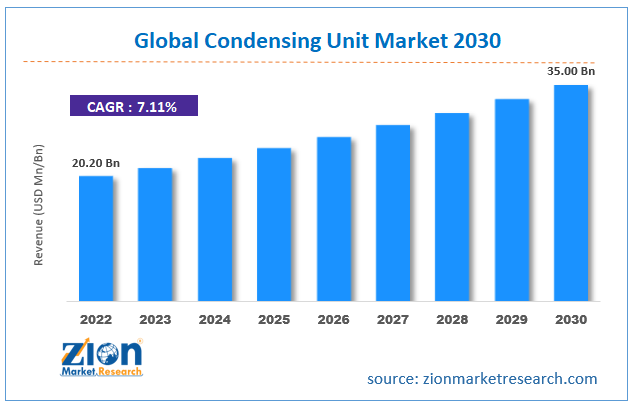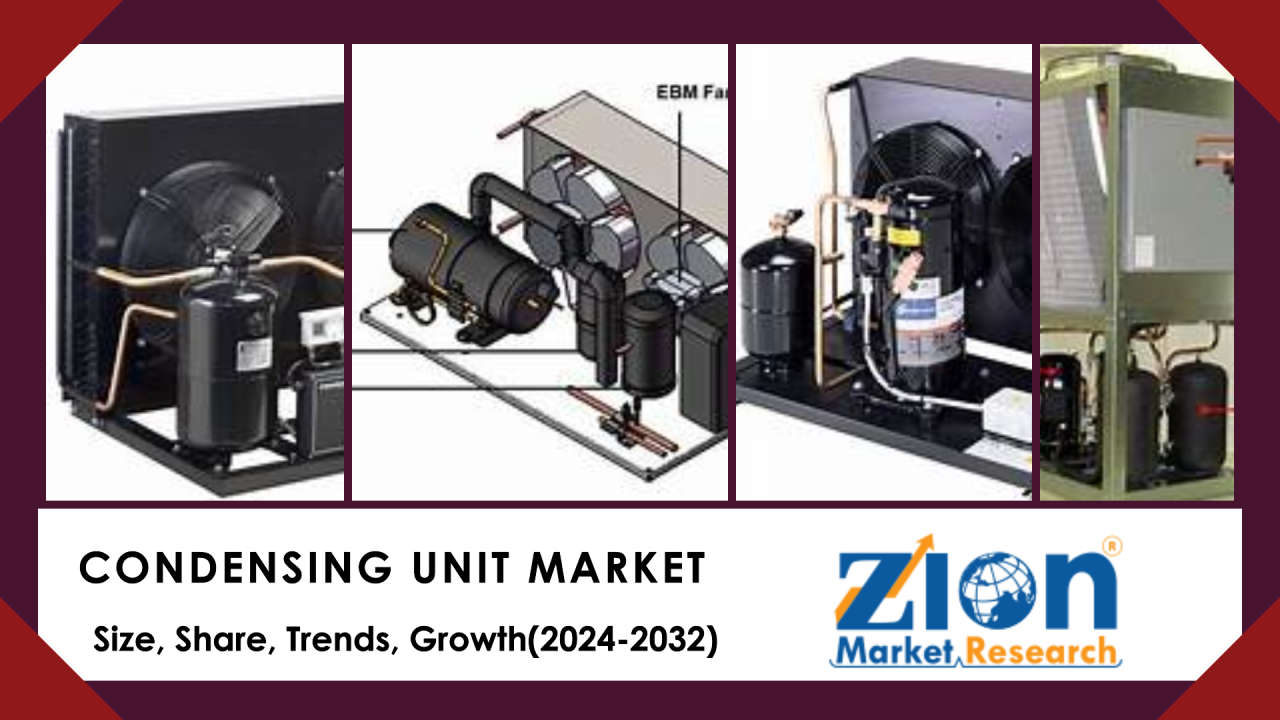The size of the global condensing unit market was estimated to be approximately USD 20.20 billion in 2024, and it is expected to increase at a compound annual growth rate (CAGR) of roughly 7.11% between 2024 and 2032 to be around USD 35.00 billion.
Introduction
Condensing units are critical components in HVAC (heating, ventilation, and air conditioning) and refrigeration systems, responsible for converting refrigerant vapor into liquid by removing heat. They play a vital role in ensuring energy efficiency and optimal performance in various applications, from residential air conditioning to large commercial refrigeration systems. This article provides an in-depth analysis of the condensing unit market, highlighting current trends, applications, key drivers, challenges, and future prospects.
Market Overview
The global condensing unit market has experienced significant growth due to rising energy efficiency regulations, increased demand for refrigeration, and advancements in technology. Condensing units are classified into different types based on their applications, including air-cooled, water-cooled, and evaporative units. As industries focus on reducing carbon footprints and improving energy efficiency, the demand for modern, high-performance condensing units is on the rise.
 Condensing Unit Market
Condensing Unit Market
Condensing Unit Industry: Synopsis
The temperature-controlling components used in air conditioners, freezers, chillers, and heat pumps are known as condensing units. By condensing a gas known as a “refrigerant,” pumping it through a system of coils, and using the air around the coils to heat and cool areas, they are able to convert energy into the form of heat. The condenser’s operation is managed by coils, fans, pumps, and electronic controllers. Heat is drawn in by the steam refrigerant in the evaporator and is accompanied by the density of the refrigerant by the compressor throughout the cooling process of a refrigeration system. At the cond, the enormous force and temperature of the vapour refrigerant are converted to liquid. Its goal is to effectively condense the compressed refrigerant vapour.
Condensing Unit Market: Indicators of Growth
A key factor boosting the condensing unit market’s development potential is the growing population in conjunction with increased disposable income in developing nations like China, Malaysia, and India. Among the industries in this province with a strong development outlook are warehousing, food processing, and food service. The average world temperature rises with increased contamination, necessitating more refrigeration in both residential and commercial areas.
 Condensing Unit Market
Condensing Unit Market
Global demand for condensing units is expected to increase in the next years due to the need for highly developed refrigeration systems in a variety of industries, including food processing, warehousing, and industrial chemical facilities. Because of their durability, adaptability, and stability, these types of condensing units are expected to see a rise in market share in the upcoming years.
Market for Condensing Units: Report Scope
 Condensing Unit Market
Condensing Unit Market
Segmenting the Condensing Unit Market
The power, commercial, and chemical segments of the condensing unit market are separated according on the end-user industry. Due to the improved air conditioning and refrigeration systems of this type of condensing unit, the commercial end-user segment held the majority of the market. This is why cold storage facilities, dining establishments, warehousing facilities, and food processing facilities use these types of condensing units. These specific units are in high demand from a number of upscale hotels, particularly on times when at least 100 tonnes of refrigeration are required.
The global condensing unit market is divided into two categories based on application, such as air conditioning and refrigeration. Since refrigeration is being used more often in cold storage facilities and food processing facilities, it has a significant market share. It is expected that this sector will continue to dominate the market in the years to come because the food and beverage industry has a significant market share in economies that show promise.
Condensing Unit Market: Geographic Perspective
The world markets for condensing units are split into five main regions based on their geographical locations: North America, Europe, the Middle East, Asia Pacific, and Latin America. North America had the largest market share because of the rising need for condensing units across a range of manufacturing sectors.
Key Market Drivers
- Growing Demand for Energy Efficiency: The global push for energy-efficient solutions in buildings and industrial applications is driving the condensing unit market. Regulatory frameworks aimed at reducing energy consumption are leading to increased adoption of high-efficiency condensing units.
- Expansion of the Refrigeration Industry: The rising demand for refrigeration in sectors such as food and beverage, pharmaceuticals, and chemicals contributes significantly to the growth of the condensing unit market. The need for reliable and efficient cooling solutions is paramount in these industries.
- Technological Advancements: Innovations in condensing unit designs, such as the integration of variable speed technology and smart controls, are enhancing system efficiency and performance. This is attracting more customers to adopt modern condensing units.
- Urbanization and Population Growth: Increasing urbanization and population growth lead to higher demand for residential and commercial cooling solutions, further fueling the growth of the condensing unit market.
Market Segmentation
The condensing unit market can be segmented based on:
- Type: Air-cooled, water-cooled, and evaporative condensing units.
- Application: Residential, commercial, and industrial.
- Region: North America, Europe, Asia-Pacific, Latin America, and the Middle East & Africa.
Application Analysis
- Residential: In residential applications, condensing units are primarily used in air conditioning systems. The increasing focus on energy-efficient home cooling solutions is driving demand for modern condensing units in this segment.
- Commercial: The commercial sector employs condensing units in various applications, including retail refrigeration, restaurant cooling, and HVAC systems for office buildings. The growing emphasis on energy efficiency and sustainability in commercial buildings is propelling market growth.
- Industrial: In industrial applications, condensing units are crucial for process cooling and temperature control in manufacturing facilities. Industries such as food processing, pharmaceuticals, and chemicals rely heavily on efficient refrigeration systems, contributing to market demand.
Regional Insights
- North America: The North American condensing unit market is characterized by a strong focus on energy efficiency and stringent regulations. The region has a well-established HVAC and refrigeration industry, driving demand for advanced condensing units.
- Europe: Europe is a key market for condensing units, with a growing emphasis on sustainability and environmental regulations. The European Union’s stringent energy efficiency standards are encouraging the adoption of high-performance condensing units.
- Asia-Pacific: The Asia-Pacific region is expected to witness rapid growth in the condensing unit market due to urbanization, rising disposable incomes, and increasing demand for residential and commercial cooling solutions in countries like China and India.
Market Challenges
- High Initial Costs: The initial investment required for high-efficiency condensing units can be a barrier for many customers. While these units offer long-term savings, the upfront costs may deter some buyers.
- Competition from Alternatives: The market faces competition from alternative cooling solutions, such as chillers and heat pumps, which can impact the market share of condensing units.
- Regulatory Compliance: Navigating the complex regulatory landscape regarding refrigerants and energy efficiency can pose challenges for manufacturers and suppliers in the condensing unit market.
Future Outlook and Opportunities
The condensing unit market is poised for significant growth in the coming years, driven by several key trends:
- Sustainable Solutions: As industries increasingly prioritize sustainability, there will be a greater emphasis on eco-friendly condensing units that utilize low-global warming potential (GWP) refrigerants and energy-efficient technologies.
- Smart Technology Integration: The integration of smart technologies and IoT (Internet of Things) in condensing units is expected to enhance monitoring, control, and energy management capabilities, appealing to consumers seeking advanced solutions.
- Emerging Markets: Developing economies, particularly in Asia-Pacific and Latin America, are expected to see substantial growth in the condensing unit market as infrastructure develops and demand for cooling solutions rises.
- Retrofitting and Upgrading: There is a growing trend of retrofitting older systems with modern condensing units to improve efficiency and reduce energy consumption. This presents significant opportunities for manufacturers and suppliers.
Conclusion
The condensing unit market is experiencing robust growth, driven by rising demand for energy-efficient solutions and advancements in technology. While challenges such as high initial costs and regulatory compliance exist, the market’s future outlook remains positive, with opportunities arising from sustainability initiatives and technological innovations. Companies that adapt to these changing dynamics and invest in research and development will be well-positioned for success in the evolving condensing unit market.
Contact Us:
Zion Market Research212
USA/Canada Toll Free: 1 (855) 465–4651
Newark: 1 (302) 444–016611\
Web: https://www.zionmarketresearch.com/
Blog: https://zmrblog.com/
